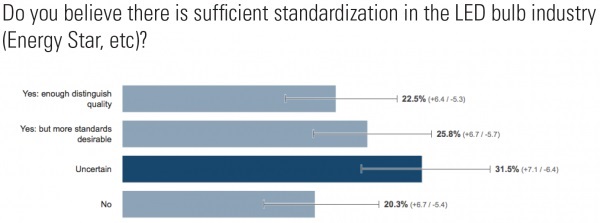In a randomized poll, over 200 business owners and managers were asked: "Do you believe there is sufficient standardization in the LED bulb industry (Energy Star, etc)?" In reply to the Leapfrog Lighting poll, 31.5% of business owners and managers were unsure if there is "sufficient standardization in the LED bulb industry", and another 20.3% believe there were insufficient standards.
The poll appears to support a call for a higher standard in design and manufacturing, including quality of light, as first highlighted by the Illuminating Engineering Society (IES). "This is the goal: lighting quality, achieving the optimum balance of the practical and the aesthetic issues of the built environment. Quality of light is essential to the quality of life." [2]
This new poll indicates that the added quality standard will be of value to business owners and managers in choosing an LED bulb. The California Quality Specification takes the view that energy efficiency is a given, and that customers place higher value on performance and quality. Business owners in this poll tend to align with this view.
The data also supports the notion that business owners value quality of light in their work and retail environments. According to a recent blog post on 1000Bulbs.com, a major supplier of LED bulbs, "Many users—beyond the professional designers and architects—demand the total light quality of spec-quality lamps." In the article, Daniel Michaelree explained that the industry is discussing adding color rendering standards to LED lamp certification. [1]
"We undertook this study, in part, to verify our assumption that business owners and managers value standards and also quality of light," explained Stephen Naor, CEO of Leapfrog Lighting, a manufacturer of spec-quality LED lighting designed specifically for business applications.
The poll indicates that only 22.5% of business owners and managers believe current standards are sufficient, while another 25.8% consider the current standards "sufficient, but more standards are desirable." The remaining respondents were uncertain or specified they felt there were insufficient standards.
Notably, in the new poll, there is minimal deviation between the opinion of business owners and business managers, although business managers were more likely to answer "no", indicating insufficient standards.
"Quality standards would go a long way to reassuring business owners that energy-saving LEDs can deliver sophisticated lighting solutions in terms of glare, light distribution, and color," said Mr. Naor of Leapfrog Lighting. "Until there are universal standards that include quality of light, business owners and managers will likely tend to acquire spec-quality bulbs—the bulbs specified by architects and designers."
In the poll, there were significant deviations in opinion when segmented by age, with 55-64 year-olds most likely to be "uncertain" of standards, at 65%. 35-44 year-olds were the most likely to answer "no" to sufficient standards, while the youngest cohort, 18-24 year-olds were the most likely to be satisfied with the current standards.
Lifestyle or urban density was also a factor, with rural business owners and managers most likely to be uncertain of sufficient standards, at 47.6%. Suburban business owners and managers were more likely to answer affirmatively to current standards (24.7%) or "yes, but more standards desirable" (33.3%). Urban were most likely to indicate standards were insufficient at 26.1%.
LED lighting standards continue to evolve, and currently include Energy Star qualification—which focuses on energy costs and other economic factors such as durability—and the standards of the Illuminating Engineering Society of North America (IESNA), known as standard LM-79. There are also voluntary standards, including a notable one from the California, the Voluntary California Quality LED Lamp Specification.
Background on Poll
The blind, randomized poll included the opinions of over 200 business owners and managers, with data collected by a research company on behalf of Leapfrog Lighting.
The poll is considered statistically accurate, subject to an error rate of 3.92%. It was conducted as a random sampling of business owners. 2372 responses to the poll were collected. The poll had an average absolute error rate of 3.92 and a confidence level exceeding 95%.












